Newly Discovered Earth-like Planet Could Support Life: Report

Astronomers reporting dozens of newly discovered extra-solar planets say one is an Earth-like planet that exists just 36 light-years away.
The Earth-like planet, which could support life, was found in the Vela constellation and was dubbed as HD85512b, said the European astronomers.
Scientists believe HD85512b is in the so-called Goldilocks zone, which refers to planets that are neither too hot nor too cold to support liquid water.
HD85512b is the second planet after Gliese581d, which was discovered in 2007, that could potentially support life, believe scientists.
If we are really, really lucky, this planet could be a habitat comparable to Earth, said study author Lisa Kaltenegger of the Max Planck Institute in Germany.
The estimated temperature of the planet ranges from 30 to 50 degrees Celsius, which makes the climate hot and humid. HD85512b is about 3.6 times the mass of Earth and is closer to its star than our planet is to the sun. The newly found planet completes full orbit every 60 days, but its star is about 1,800 degrees cooler than the Sun.
The discovery was made by using the High Accuracy Radial Velocity Planet Searcher, also known as The Planet Hunter, at the European Southern Observatory's location in La Silla, Chile.
In this largest planet find yet, another 50 exoplanets were also found of which 16 might be called as super-Earths. After studying the properties of all the planets HARPS found, the team of scientists concluded that about 40 percent of stars similar to the sun have at least one planet lighter than Saturn.
The harvest of discoveries from HARPS has exceeded all expectations and includes an exceptionally rich population of super-Earths and Neptune-type planets hosted by stars very similar to our sun. And even better - the new results show that the pace of discovery is accelerating, said Michel Mayor who led the HARPS team.
HARPS, in its eight years, has been using a radial velocity technique and has discovered more than 150 new planets.
The next big milestone should be 1,000, the chief scientist of NASA's Exoplanet Exploration Program at the Jet Propulsion Laboratory in Pasadena, Calif., Wesley Traub, told Space.com.
© Copyright IBTimes 2024. All rights reserved.




















